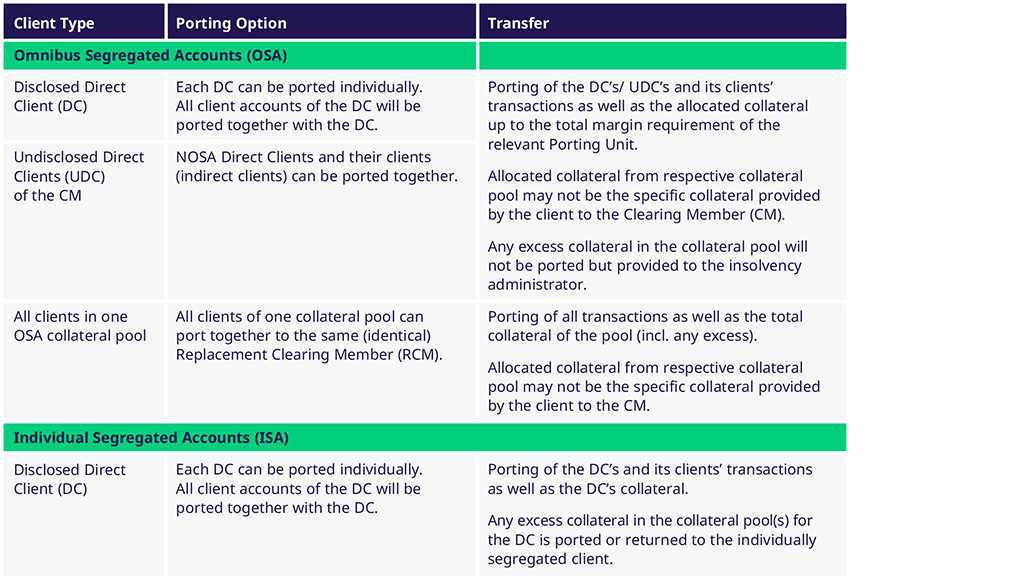Porting under EMIR
Overview of content
- General information
- Client porting process overview
- Mandatory prerequisites
Client porting process overview
In case of a termination of a Clearing Member, Eurex Clearing informs all market participants about the Porting Period in which certain requirements must be fulfilled to enable porting.
Upon the publication of the Porting Notice, all Direct Disclosed Clients (DCs) may use the Election Notice to provide their choice to Eurex Clearing: they may opt to transfer to a Replacement Clearing Member or to close-out (termination).
Undisclosed Direct Clients (UDCs) that are part of the same Transaction Account must port together; they all need to unanimously elect the Replacement Clearing Member as their new Clearing Member. Please contact your Clearing Member for further information.
Prior to default, the Clearing Member may designate a back-up Clearing Member for each Direct Client Account. The designation as a back-up Clearing Member does not impose any obligations to become the new Clearing Member in case of the termination of the Clearing Member.
Transaction Accounts Groups are also referred to as "Porting Units". The following set-ups can be ported:

The Porting Period starts with the occurrence of the Insolvency Termination Event of the Clearing Member’ or the publication of the Porting Notice and expires (a) with respect to a DC Transaction Account Group the next business day following the default at 13:00 CET and (b) with respect to a NOSA UDC Transaction Accounts Group, until lapse of 4 business hours following the occurrence of an Insolvency Termination Event or after the publication of the ECM Porting Notice. If a Porting Unit wishes to port its segregated transactions and allocated collateral to a new Clearing Member, the prerequisites ("Porting Requirements") have to be fulfilled (a) with respect to a DC Transaction Account Group by 13:00 CET on the business day following the default and (b) with respect to a NOSA UDC Transaction Accounts Group after 4 business hours after the occurrence of an Insolvency Termination Event or after the publication of the ECM Porting Notice. Under certain circumstances, Eurex Clearing may extend the Porting Period at its own discretion.
In addition to the required activities that need to be fulfilled and forms/documents that need to be submitted during the Porting Period, the likelihood of a successful porting also depends on the compatibility of the Replacement Clearing Member's and Disclosed Direct Client’s infrastructure and set-up in the Eurex Clearing systems.
If, at or prior to the end of the Porting Period, Eurex Clearing determines that all Porting Requirements of a specific Porting Unit are fulfilled, Eurex Clearing will send out a confirmation to the Replacement Clearing Member(s) and the affected Direct Disclosed Clients stating that the Porting Requirements are fulfilled and that porting will take place.
The porting of the client transactions is facilitated by an assumption of contract under OSA and ISA. Any outstanding obligations (i.e. cash payments, Margin, Variation Margin) by the Defaulted Clearing Member under these transactions towards Eurex Clearing must be provided by the Replacement Clearing Member.
In addition to the fulfilment of the Porting Requirements, the Replacement Clearing Member must provide documentation as in the case of a regular Clearer Change to enable the technical set-up of the clients in its Eurex Clearing environment.
If any of the Porting Requirements of a Porting Unit are not fulfilled within the Porting Period or a Disclosed Direct Client has opted for close-out, the respective own transactions and the indirect client related transactions of this Porting Unit will be handled within the standard Default Management Process. Close-out netting will take place and the respective Difference Claim for the Direct Client including clients’ transactions and collateral will be calculated.
If in the case of omnibus segregation there is a positive Difference Claim for a Porting Unit, Eurex Clearing may return cash and/or non-cash collateral that have been delivered to Eurex Clearing as Margin to the Disclosed Direct Client following the conclusion of the Default Management Process. Otherwise, any payment will be provided to the insolvency administrator for the account of the respective clients of the Defaulted Clearing Member. If Eurex Clearing is required to cover a negative Difference Claim with actually delivered securities, allocated securities will only be liquidated in an amount to recover the respective negative Difference Claim. On request any remaining allocated securities pledged as collateral will be transferred to the Disclosed Direct Client or otherwise released to the insolvency administrator indicating for which Porting Unit it was allocated.
If in the case of the individual segregation there is a positive Difference Claim, Eurex Clearing may return cash and/or non-cash collateral that have been delivered to Eurex Clearing as Margin to the individually segregated client following the conclusion of the Default Management Process.
Eurex Clearing is entitled to set-off any shortfall of a Difference Claim against the Clearing Member for client business against any Difference Claim owed to the Clearing Member for proprietary business, but not vice versa.
